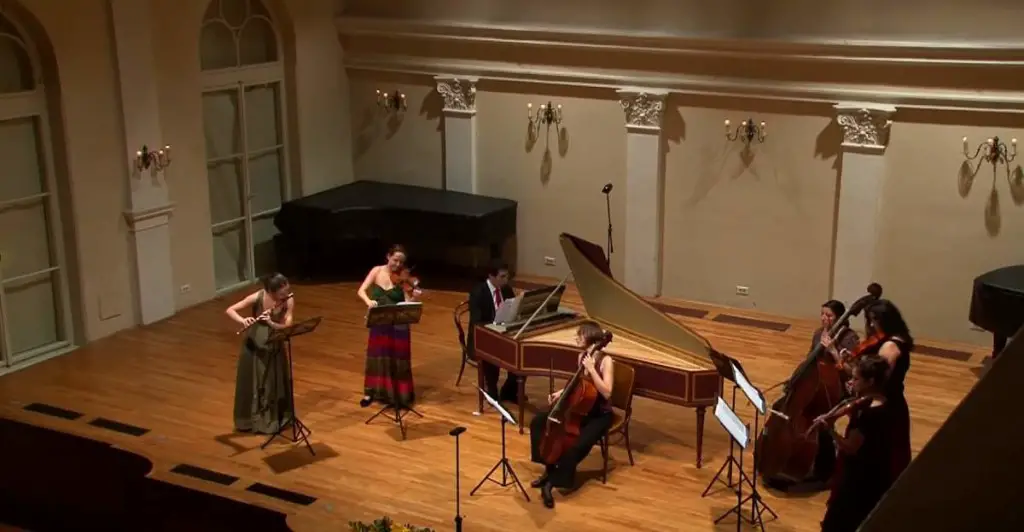FestspielOrchester Göttingen performs Johann Sebastian Bach’s Brandenburg Concerto No. 5 in D major, BWV 1050. Live and HD video recorded at the Gala Concert of the Göttingen International Handel Festival, 2016. Conductor and harpsichord: Laurence Cummings.
Brandenburg Concerto No. 5 by Johann Sebastian Bach
Johann Sebastian Bach’s Brandenburg Concerto No. 5 in D major, BWV 1050, is one of the six concertos he dedicated to Christian Ludwig, Margrave of Brandenburg-Schwedt, in 1721. These concertos are celebrated for their innovative instrumentation and intricate counterpoint. Brandenburg Concerto No. 5 is particularly notable for its prominent and groundbreaking harpsichord part, which not only functions as a continuo instrument but also takes center stage as a soloist.
The concerto features a solo trio of flute, violin, and harpsichord, with the harpsichord performing an extended and virtuosic cadenza in the first movement. This work exemplifies Bach’s skill in blending different musical textures and forms, creating a rich and engaging tapestry of sound that has captivated audiences for centuries.
This performance follows Bach’s original orchestration and is performed on original instruments: the performers are Laurence Cummings, harpsichord and director, Kate Clark, baroque flute (traverso); Elizabeth Blumenstock, solo baroque violin, Wolfgang von Kessinger, baroque violin; Klaus Bundies, baroque viola, Kathrin Sutor, baroque cello, and Paolo Zuccheri, violone.
Brandenburg Concerto No. 5 makes use of a popular chamber music ensemble of the time (flute, violin, and harpsichord), which Bach used on its own for the middle movement. It is believed that it was written in 1719, to show off a new harpsichord by Michael Mietke (c. 1656/1671 – 1719, a German harpsichord and harp maker) which Bach had brought back from Berlin for the Köthen court.
It is also thought that Bach wrote it for a competition at Dresden with Louis Marchand (2 February 1669 – 17 February 1732, the French Baroque organist, harpsichordist, and composer); in the central movement, Bach uses one of Marchand’s themes. Marchand fled before the competition could take place, apparently scared off in the face of Bach’s great reputation for virtuosity and improvisation.
The concerto is well suited throughout to showing off the qualities of a fine harpsichord and the virtuosity of its player, but especially in the lengthy solo cadenza to the first movement. It seems almost certain that Bach, considered a great organ and harpsichord virtuoso, was the harpsichord soloist at the premiere. Scholars have seen in this work the origins of the solo keyboard concerto as it is the first example of a concerto with a solo keyboard part.
Movements
1. Allegro
The first movement of Brandenburg Concerto No. 5 begins with a lively and intricate theme introduced by the ensemble. The flute, violin, and harpsichord engage in a dynamic and spirited interplay, exchanging and developing melodic lines with great virtuosity. The movement is characterized by its energetic tempo and complex counterpoint, creating a sense of joyful exuberance.
A defining feature is the extended harpsichord cadenza, an unaccompanied passage that showcases the instrument’s capabilities in a dazzling display of technical prowess and creativity. This cadenza, unprecedented in Bach’s time, elevates the harpsichord from its traditional role as a continuo instrument to that of a soloist, marking a significant innovation in the concerto form.
2. Affettuoso
The second movement, marked Affettuoso, is a lyrical and expressive contrast to the lively first movement. It features a more intimate dialogue between the solo instruments, with the harpsichord, flute, and violin weaving a delicate and tender tapestry of sound. The movement is characterized by its gentle, flowing melodies and the emotional depth conveyed through subtle harmonic shifts and expressive phrasing.
The harpsichord, while less dominant than in the first movement, still plays a crucial role in the texture, providing both harmonic support and intricate counter-melodies. The Affettuoso creates a serene and reflective atmosphere, highlighting Bach’s ability to convey profound emotion through his music.
3. Allegro
The final movement returns to the lively and joyful character of the first, marked Allegro. It features a robust and energetic theme introduced by the soloists and echoed by the orchestra. The movement is structured as a lively fugue, with the flute, violin, and harpsichord engaging in a playful and intricate contrapuntal exchange.
The harpsichord once again takes a prominent role, delivering rapid and virtuosic passages that drive the music forward with relentless energy. The interaction between the soloists and the ensemble creates a vibrant and exhilarating conclusion to the concerto, demonstrating Bach’s mastery of form and his ability to blend complexity with sheer musical delight.
You can also watch the complete Brandenburg concertos.
The Göttingen Handel Festival is one of the oldest and most prestigious festivals in Europe. Every year, musicians from around the world celebrate the music of Handel and his contemporaries with performances of operas, oratorios, and many other concerts.
Sources
- Brandenburg Concertos on Wikipedia
- Brandenburg Concerto No. 5 on Wikipedia
- Brandenburg Concerto No. 5 in D major, BWV 1050 (Bach, Johann Sebastian) on the International Music Score Library Project website
